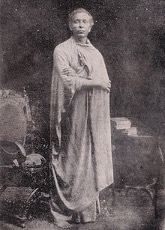Rescued From the Nation: Angarika Dharmapala and the Buddhist World. Steven Kemper. (Chicago: University of Chicago Press, 2015). / Reviewed By Pouya Nekouei. Ph.D. student (Middle Eastern History), Department of Middle Eastern Studies, University of Texas, Austin, TX, USA / May 2023

Steven Kemper in his monumental monograph Rescued from the Nation: Angarika Dharmapala and the Buddhist World portrays the life and time of Angarika Dharmapala (1864- 1933), a prominent fine de siècle religious activist and reformer in modern Buddhist revivalism during the late nineteenth and early twentieth century.
Although Dharmapala was Sri Lankan and one expects his immediate audience to be South Asian, Kemper marvelously shows myriad interactions, exchanges, and contestations around him and his activities on a more extensive and global scale. In this vein, Kemper speaks of his "this-worldly" asceticism.
Therefore, this book is neither a mere biographical account of Dharmapala's life nor a plain textual investigation of his writings and ideas. We read about his voyages to Europe, the United States, Japan, and India. We witness his interactions, dialogues, competitions, and disagreements with a wide range of interlocutors of varied origins engaged in the discourse of universalism and religious reform. Moreover, the socio-cultural and political subtilities of the time are masterfully depicted. Through Kemper's narrative, we encounter questions pertaining to empire, elites, debates around religion and universalism, contestations over self and identity, and not but least, the question of space and place.
Kemper offers a profound narrative about Dharmapala and his relationship with Buddhism. Buddhism for Dharmapala is both a self-quest and a multi-faceted intellectual, cultural, and political agenda. According to Kemper, there was not a single Buddhism, but rather several Buddhisms in his life history, three of which are as follows:
1. The Buddhism that he practiced
2. His quest for the cause of Buddhism in India, i.e., during his stint in Kolkata and Bodh Gaya
3. The Buddhism he preached to the West
These different configurations of Buddhism provide a complex representation of this figure that cannot be reduced to grand narratives of Buddhism, Buddhist reform, or Buddhist thought. This study reveals how the modernity of Buddhism was a multifarious personal, political, social, cultural, and intellectual venture.
We learn that Dharmapala had contacts with Western theosophists like Helena Blavatsky, Henry Still Olcott, and Anne Besant; with Indian reform figures such as Tagore, Vivekananda, and his disciple known as Sister Nivedita; the Japanese intellectual Okakura Kakuzo (Tenshin) and the British colonial officers and western Orientalists. While there were personal motivations for him to turn into an ascetic and a reform figure associated with modern Buddhism, Kemper hints that, ostensibly, the global cultural milieu reciprocally informed the formation of his intellectual character.

The question of space and place are dealt with in at least two significant ways. We read about Dharmapala's mobility in Asia, Europe, and America. Japan, for instance, became a significant space in his intellectual life. Japan, for him, signified the harbinger of civilization, modernity, and progress for Asians. Dharmapala's relationship with the West was complex and relatively ambivalent. While he venerated the West and traveled there, he disapproved of the British officials in India, whom he considered the Other of the cultured West.
Therefore, unlike reactionary revivalists of the nineteenth and twentieth centuries, Angarika Dharmapala's relationship with the empire, regardless of its global superiority and its condescending modality towards the 'rest', was neither a piquant denial nor necessarily a pacificist critique, similar to a tone voiced by the likes of Tagore and Gandhi. Dharmapala thought of the "greatness of the English" and hoped to "make them learn Dhamma". Therefore, Buddhism in the context of empire found an elan of universalism, a universalism that did not gain mass-based political vivacity.
Another exciting aspect of notions of place and space is associated with Bodh Gaya. This aspect is well-sketched and detailed in the book. Bodh Gaya as a site of religiosity became contested between Dharmapala and the Mahant. Bodh Gaya, as the author submits, figured as a central point in the discourse on the universalism of Buddhism.
This point is a thought-provoking facet in the book vis-à-vis questions of nationalism and internationalism: While for many interlocutors of the same period, the idea of a specific place animated nationalism, Dharmapala, no matter how feeble, made universalist claims about the centrality of Bodh Gaya for his project vis-a-vis Buddhism. In this light, Bodh Gaya had to be "recovered."
Dharmapala's quest for resuscitating and rearticulating Buddhism should be contextualized in what Kemper, following C. A Bayley refers to the phenomenon of "uniformities" in the "long nineteenth century." In the latter half of the nineteenth century, we witness the formation of a global intellectual lingua franca around notions of civilization, culture, and religion.
This situation created a habitus by which thinkers and activists were shaped but also shaping common global parlance and modality of imagination. In this context, Dharmapala engaged with Hinduism's modern sources such as the thoughts of Swami Vivekananda, who had been following similar projects.
At the same time, while traveling in the West, he could also communicate well with Western and Christian audiences, presenting Buddhism with similar parlance and terminologies familiar to such worldviews.
This mentioned aspect of universalism and its association with Dharmapala's Buddhist project is very well-sketched and is a central theme of the book. Dharmapala considered Buddhism as a 'world religion' as a universal category that, due to its spiritual nature, could bring wellness to the West and its materialism. This was similar to Vivekananda's presentation of Hinduism as a universal religion, not a sectarian one in the West.
Drawing from and somewhat modifying Masuzawa's argument on the discourse of world religion in the nineteenth century, Kemper shows that such notions of religiosity were, in fact, a by-product of nineteenth-century thought. However, such shared idiomatic sensibilities did not necessarily lead to the erosion of differences and the formation of a Universalism.
For instance, Dharmapala broke away from the Theosophists, with whom he initially shared various similarities. His ideological differences with Vivekananda grew specifically after the famous Parliament of World Religion in 1893 in Chicago; after this point, Vivekananda emerged as a more influential figure in the discourse on religion and spirituality than Dharmapala.
Reading the book also makes us ponder the class question vis-à-vis Angarika Dharmapala and his project of reformism. The majority of the figures whom he interacted with were from high echelons of society: From the Bhadralok to the international theosophists - from whom he later departed - to his circles of friends in Kolkata such as Neel Kamal Mukherjee and Norendronath Sen all formed a specific elite class of intellectuals during the late nineteenth and early decades of the twentieth century.
Therefore, he markedly differed from a prominent thinker and political activist of India, B.R Ambedkar, who employed Buddhism but was a staunch advocate of mass politics. Hence, although Dharmapala's intellectual claims were global, they remained confined to a tiny intellectual layer. This aspect of him clearly explains the frailty of his Buddhist revivalism as an effectual political project aimed at the masses and structures of power. This elitist nature of his project appears in several passages of the book.
While the book has meticulously detailed information about Dharmapala, there are several considerations regarding the book. In the introduction, a series of biographical information are described. The author sets to rethink some common assumptions associated with his personal life, including his celibacy, relationship with his parents, and relocation to India.
However, some of these biographical data are not treated theoretically but presented as passing facts in the larger narrative. Detailed information and long quotations constitute a significant part of the book. The book is heavily inundated with these details and long quotations. This aspect is an obstacle in two ways: it disrupts the narrative flow and blurs the more powerful theoretical understanding one could draw from the book. Nevertheless, the book is a groundbreaking work of scholarly depth that expands our horizons on the global intellectual milieu of the early twentieth century.
This work is not only beneficial for South Asian and religious studies scholars but provides a unique model for scholarly works for those interested in intellectual histories of different contexts, as well as social history.





